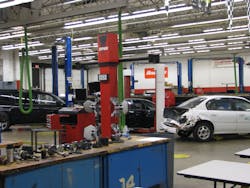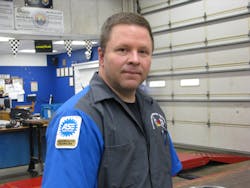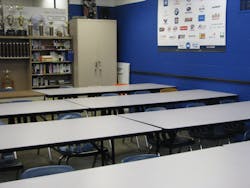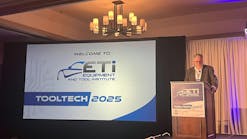High school automotive programs give students competitive edge
With a highly structured and focused training schedule, high school automotive programs across the country are developing career-ready service repair students. Motor Age got a glimpse inside high school automotive programs by visiting Valley Forge High School’s Tech Prep Automotive Service Technology program in Parma Heights, Ohio.
Career-ready
Valley Forge’s automotive training program is accredited by the National Automotive Technicians Education Foundation (NATEF). The mission of NATEF is “to improve the quality of automotive technician training programs nationwide at secondary and post-secondary, public and proprietary schools. To accomplish this mission NATEF examines the structure, resources and quality of training programs and evaluates them against standards established by the industry.”
In accordance with NATEF’s training program, over the span of the school year eleventh graders cover three main topics: introduction to automotive, brakes, and electrical and electronics. In twelfth grade, students spend fifteen weeks on suspension and steering, sixteen weeks on engine performance and wrap up the school year with heating and air conditioning.
Gary Mitchhart has been the instructor of the program for the past ten years. Mitchhart’s prior teaching experience at Ohio Technical College and his experience of working at dealerships and independent shops equally over the past thirty years, has helped him present the learning material through an environment that is representative of the inner-workings of a repair shop. “During the first nine weeks they’re just learning about intro to automotive. You have to wear work clothes; you have to learn basic things like washing your hands. I take nothing for granted. I’ve set the class up to not only teach NATEF but to imitate what it would be like to work in a real repair shop,” Mitchhart explains.
The automotive training facility at Valley Forge certainly has the feel and function of a real repair shop. Funded by grants through the Carl D. Perkins Career and Technical Education Act, the shop is equipped with multiple lifts, an expansive tool room, wheel alignment systems and all the necessary equipment found in a repair shop. Valley Forge keeps a lab of 25 vehicles for students to work on while learning the NATEF material. To ensure the students are prepared for the automotive technology they will face while working in the industry, the program is currently seeking to upgrade the fleet so that the vehicles are no older than 7 years.
While students partake in plenty of hands-on learning in the shop, they also learn through lectures, reading materials and workbooks in the classroom. Mitchart explains, “Students need to learn both technical and academic skills. The electrical and electronics portion, for example, is very physics heavy. We start with learning about the atom and matter, and then we gradually move on to topics such as basic circuitry, voltage drop, amperage, checking for resistance and using a voltmeter and an oscilloscope.”
At the end of their senior year, the students take the ASE Student test, which is paid for and offered by the school, as a way for the state to verify that the students have been properly trained on the NATEF material. Even though the content of the ASE Student test is very similar to the industry ASE test, the certificates earned thereafter are not interchangeable. In order to get the industry ASE certificate and patch, one must also have two years of work experience, which ASE Student Certification does not require.
In regards to the content and comparability of the student test to the industry ASE test Mitchhart states, “The questions on the ASE Student test are not watered down. Yes, there are fewer questions, but they’re the same type of questions as the industry ASE test.” He continues, “So you’re probably wondering ‘why don’t the students take the industry test?’ No school in America offers that test on site. It has to be proctored by an independent testing facility. Students can go take the regular ASE test, but they won’t get a certificate or a patch until they have two years of work experience.”
Nonetheless, the Student ASE test holds merit. Mitchhart attests to how well it speaks to the knowledge of the students. He explains, “For these students to take the ASE Student test and pass it, it’s absolute testament that they can do the job. It’s been a very useful way to show that these students are career-ready.”
Education evolution
Mitchhart has noticed a significant change in the structure of high school automotive programs over the years and the type of students the programs attract. “30 years ago there wasn’t a classroom and there were no lectures. It was very basic because cars weren’t as complex. Now, we follow a very structured and detailed training program.” He continues, “We’re seeing a huge change in the type of students who are entering the program. As cars become more advanced, high school automotive programs are no longer a last resort for students who don’t know what they want to do. We’ve had some students who have entered the program and then left soon after they realized how in-depth it is. Those who stay in the program know that automotive work is what they want to do.”
One of Mitchhart’s students from the 2015/2016 school year just started at a Ford dealership at the age of 17; he’s also an honor student. Mitchhart has seen his former students succeed in a variety of different careers. While the majority go on to work at new car dealerships, others are hired at independent repair shops or specialize in certain fields in the automotive industry. For example, an alumnus of Valley Forge’s program is now an electrical engineer for Roush Racing.
Mitchhart urges repair shops to seek out high school students for new talent. He expresses, “Businesses really do need to look the high school students first. We’re just as competitive as community colleges or technical colleges that follow the NATEF curriculum because we are all teaching the same exact material. High schools even have an advantage due to small class sizes, which allows for more individualized attention.” Additionally, high school students can quickly determine from a young age if the automotive field is a good fit. “There’s no doubt these students will make fantastic long-term employees.”




